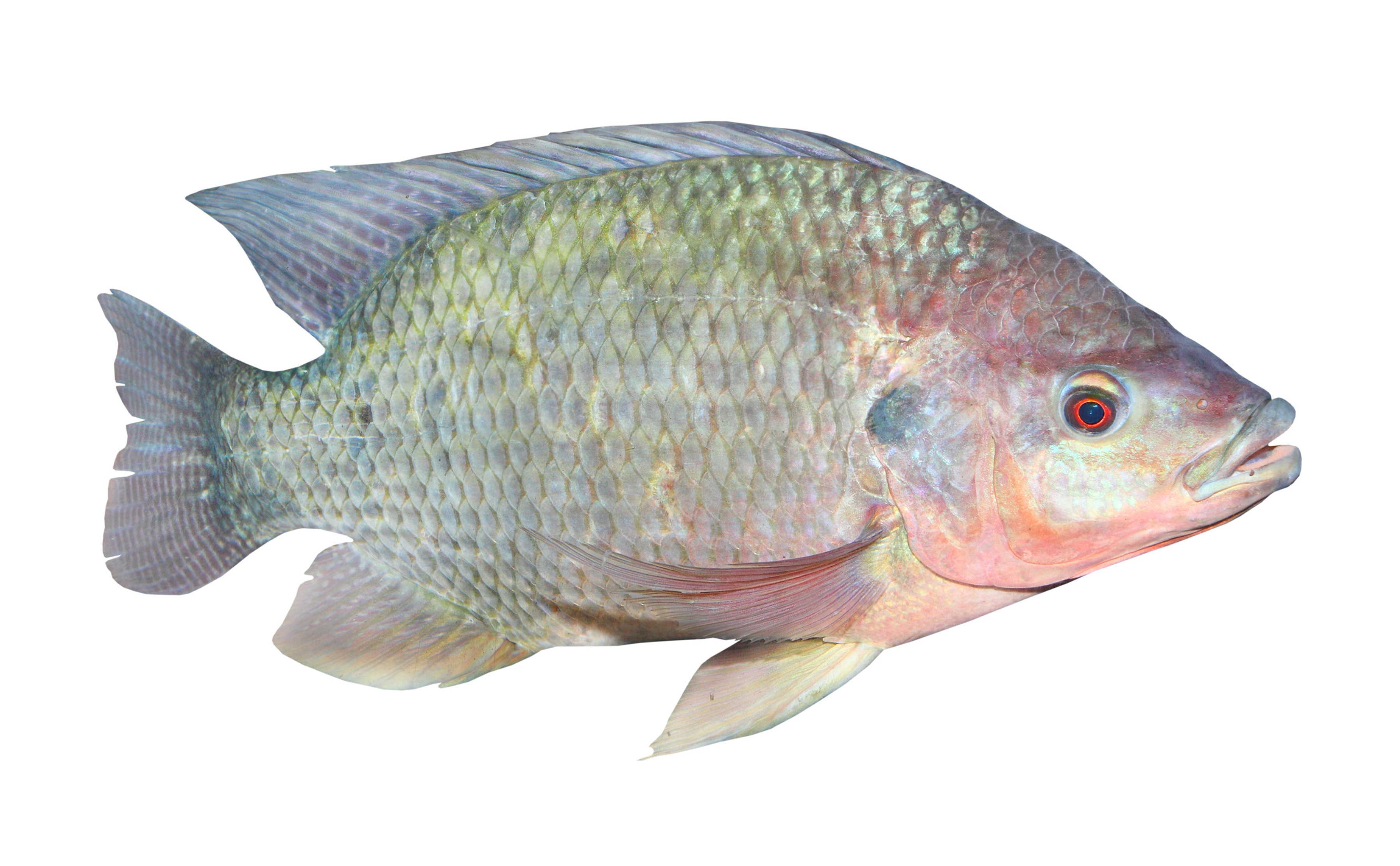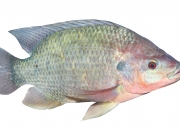By Kevin Fitzsimmons
University of Arizona
One of the great advantages of tilapia for aquaculture is that they feed on a low trophic level. The members of the genus Oreochromis are all omnivores, feeding on algae, aquatic plants, small invertebrates, detrital material and the associated bacterial films. The individual species may have preferences between these materials and are more or less efficient depending on species and life stages in grazing on these foods. They are all somewhat opportunistic and will utilize any and all of these feeds when they are available. This provides an advantage to farmers because the fish can be reared in extensive situations that depend upon the natural productivity of a water body or in intensive systems that can be operated with lower cost feeds.
In extensive aquaculture, the fish will be able to grow by eating algae and detrital matter and the farmer can grow more fish in a given area because the fish are depending directly on the primary productivity of the body of water, primary consumers. Fish which feed on a higher trophic level, eating larger invertebrates or small fish, are secondary consumers and a system can only support a fraction of the biomass of secondary consumers compared to primary consumers.
In intensive systems, tilapia have the advantage that they can be fed a prepared feed that includes a high percentage of plant proteins. Carnivorous fish require fish meal or other animal proteins in their diets, which in general are more expensive than plant proteins. Nutritional studies which substitute plant proteins supplemented with specific amino acid supplements may lower costs, but still not to the level that can be achieved with tilapia diets.
Complete diets are used in systems that cannot provide any dependable nutrition. This would include intensive recirculating systems, cages placed in water with low productivity and even heavily stocked ponds that do not provide enough nutrition for all the fish in the system. Supplemental diets will provide only portions of the nutritional demands of the fish, with the assumption that they will get most of the nutrients from the growing system. Supplemental diets are usually much less expensive than complete diets and usually high in carbohydrates. Some simple supplemental diets serve a dual purpose of fertilizing the pond as well increasing productivity. Considerable research has been conducted on complete diets and on fertilization programs for natural and man-made water bodies. Development of supplemental diets directed to specifically provide limiting nutrients is a growing area of research.
Tilapia exhibit their best growth rates when they are fed a balanced diet that provides a proper mix of protein, carbohydrates, lipids, vitamins, mineral and fiber. Jauncey and Ross (1982), El-Sayed and Teshima (1991) and Stickney (1996) provide excellent reviews that examine the details of tilapia nutrition. The nutritional requirements are slightly different for each species and more importantly vary with life stage. Fry and fingerling fish require a diet higher in protein, lipids, vitamins and minerals and lower in carbohydrates as they are developing muscle, internal organs and bone with rapid growth. Sub-adult fish need more calories from fat and carbohydrates for basal metabolism and a smaller percentage of protein for growth (Table 1). Of course the absolute amount the fish is eating will still be increasing as the fish is much larger. Adult fish need even less protein, however the amino acids that make up that protein need to be available in certain ratios (Table 2). Feed formulators will adjust protein sources to fit the desired pattern of amino acids through the growth cycle. Broodfish may require elevated protein and fat levels to increase reproductive efficiency (Santiago et al. 1985; Chang et al 1988).
Table 1. Typical protein requirements for tilapia
1. First feeding fry 45 - 50 %
2. 0.02 - 2.0 g 40%
3. 2.0 - 35 g 35%
4. 35 - harvest 30 - 32 %
Table 2. Essential Amino Acids in experimental tilapia diets at the University of Arizona.
Essential Amino Acids g/kg diet % of protein
Arginine 15 7.5
Histidine 5 2.3
Isoleucine 9 4.3
Leucine 15 7.0
Lysine 16 5.0
Methionine 5 (74% of Cysteine) 1.7
Phenylalanine 15 4.5
Threonine 10 3.6
Tryptophan 2 1.0
Valine 12 5.8
In general, the lipid requirements for fish under two grams represent 10% of the diet. This decreases to 6-8% from two grams to harvest. The lipids should contain both omega 3 and omega 6 fatty acids. Each fatty acid should represent 1% of the diet, although some reports suggest that fish grow better with a higher proportion of omega 6 to omega 3. The fiber component is usually the reciprocal of the lipid content. That is starting at 6-8% in small fish up to 35g and increasing to 10% above 35g. Carbohydrates usually represent less than 25% of the diet for fish under a gram and increases to 25 - 30% for fish greater than a gram up to harvest.
Carbohydrates are often supplied by the least expensive ingredients in the diet. Corn, wheat, rice and a number of agricultural byproducts are typical carbohydrate sources. The ratio of energy supplied by lipids and carbohydrates to the proteins available in the diet is often a critical measure. Shiau (1997) provides a comprehensive review of carbohydrate and fiber utilization in tilapia.
Vitamins and minerals are critical to proper nutrition in tilapia and considerable research has been conducted to determine these requirements (Watanabe et al. 1997; El-Sayed and Teshima 1991; Roem, et al. 1990; Jauncey and Ross 1982). Commercial premixes are available which allow feed makers to purchase a whole group of micronutrients rather than attempting to determine how much is available from the productivity of the system and the other ingredients (Table 3).
Table 3. Vitamin and mineral mix used in University of Arizona tilapia diet.
(recommended amounts before pelletizing)
Vitamins
mg/kg I. Units
Thiamin 11
Folic acid 5
Riboflavin 20
Vitamin B12 0.01
Pyridoxine 11
Choline 275
Panthothenic acid 35
Nicotinic 88
Ascorbic acid (C) 375
Vitamin K 4.4
Vitamin A 4,400
Vitamin D3 2,200
Vitamin E 66
Minerals g/kg
Calcium Ca 3.0
Phosphorus P 7.0
Magnesium Mg 0.5
Iron Fe 0.15
Zinc Zn 0.20 (Note: Should not be above 0.3 (300 ppm)
Copper Cu 0.003
Manganese Mn 0.013
Selenium Se 0.0004
Iodine I 0.001
Feed Formulations
Feed manufacturers will adjust the mix of ingredients to create what are called “Least Cost Feed Formulations”. These are formulations that use spreadsheet and database programs to examine the nutritional characteristics of many ingredients at the same time. The program can then select the mix of ingredients that meet all the nutritional requirements at the lowest manufacturing cost. These feeds will then meet the “Guaranteed Analysis” on the manufactures label, which tells any purchaser of the feed what they can expect from the feed.
This is meant to be only a short introduction to tilapia nutrition. Specific nutritional needs vary by species, age of fish, production system, and salinity. A wealth of information is available and feed manufacturers have developed considerable expertise. Tilapia nutrition is critical to further increases in efficiency and profitability for the small producer growing for personal consumption and the large producer in international trade.
References
Chang, S.L., Huang, C.M. and I.C. Liao 1988. Effects of various feeds on seed production by Taiwanese red tilapia. In Proceedings of the 2nd International Symposium on Tilapia in Aquaculture. Pullin, R.S.V., Rhukaswan, T., Tonguthai, K. and Maclean, J.L., Eds. ICLARM, Bangkok.
El Sayed, A.F.M., and S.I. Teshima 1991. Tilapia nutrition in aquaculture. Reviews in aquatic sciences. 5 (3-4):247-265.
Jauncey, K. and B. Ross 1982. A Guide to Tilapia Feeds and Feeding. University of Sterling, Scotland.
Roem, A.J., R.R. Stickney, and C.C. Kohler 1990. Vitamin requirements of blue tilapias in a recirculating water system. Progressive Fish Culturist 52:15-18.
Santiago, C.B., Aldaba, M.B., Aubuan, E.F. and M.A. Laron 1985. The effects of artificial diets on fry production and growth of Oreochromis niloticus breeders. Aquaculture, 47:193.
Shiau, S.Y. 1997. Utilization of carbohydrates in warmwater fish - with particular reference to tilapia, Oreochromis niloticus x O. aureus . Aquaculture 151:79-96.
Stickney, R.R. 1996. Tilapia update, 1995. World Aquaculture 27(1):45-50.
Watanabe, T., Kiron V. and S. Satoh 1997. Trace mineral in fish nutrition. Aquaculture 151:185-207.








